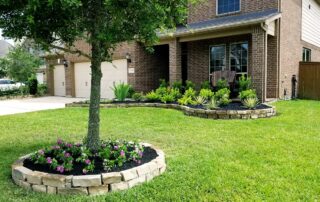How Thick Should Mulch Be in Flower Beds?
Mulch is an excellent method of protecting your flowers. But how much mulch is needed in flower beds? Ideally, the mulch layer ought to be 2 to 4 inches thick. A thinner layer won't offer enough protection. If the soil is too low it can block water from reaching the root.
Clippings of grass
You can enhance the beauty of your flower beds with grass clippings for mulch. They're free and much more eco-friendly than straw. They also provide the necessary moisture and provide insulation to your plants, which reduces transpiration. It is also possible to enrich your soil with grass clippings that are a fantastic source of nitrogen. They can be used as mulch for flower beds that are up to two inches thick.
Grass clippings have between one and two percent nitrogen, 0.3% phosphorus, 1.3 0.3% to 2.3 percent potassium, and trace elements. Clippings of grass can also be used to create fertilizers. You can use the clippings to create a variety of landscaping tasks, such as garden beds, flower beds and lawns.
Composting grass clippings in flower beds is a better choice than raking them in the ground. The clippings are more nutritious and will decompose faster if they are composted.
Leaves
Leaf mulch can be used to enrich soil. They're a balanced mixture of carbon and nitrogen and give soil microbes constant nutrition. Shredded leaves can provide nutrients to soils and serve as a natural pest control method by stopping weeds, keeping the soil moist and preventing their growth.
It is easy and free to use leaves as mulch. The trick is to shred them before. This makes the mulch to break down more effectively and also looks more attractive. It will also prevent moldy mats from growing on the soil. Shredded leaves also be broken down more quickly.
Although leaves that are whole can be attractive, infiltration problems can be a problem. They can also form mats that block water from reaching the soil if not broken. They can also contribute to acidity and may contain compounds that can be harmful to many plants.
Pine needles
Pine needle mulch is a fantastic method to mulch flower beds. It will not only suppress weeds but will increase soil porosity and will add nutrients to your soil. It's also extremely easy to remove. The key is to use a layer of pine needle mulch that's at least 2 to 3 inches thick. Mulch that is thick will keep weeds out of it.
The pine needle mulch can be used in flower beds for winter protection. It is recommended to spread the mulch out several inches around the base of the plants to shield the roots. The pine needles are placed four to five inches high over trees or trunks.
Pine needles are a great option for flower beds due to the fact that they won't compress the soil. They also prevent weed seeds from germinating, and they are broken down slowly. This means that you don't have to replace the pine needle mulch every year. They're also lighter than other mulches, which makes gardening easier for gardeners.
Compost
It's a fantastic soil amendment. It can be added in the spring or the fall. In the fall, adding it can help make your soil richer and your plants will grow better. It is recommended to apply compost up to 12 inches deep. Before adding compost, the soil needs to be damp. You can check the moisture content of the soil by squeeze it - if it squeezes out the water, it's too wet.
The best compost is one that is fully decomposed. This compost is dark brown, brittle and has an earthy smell. It is able to improve soil structure by taking out heavy soil and providing body and texture to soils with less. It also increases the growth rate of all types of plants, even flowers. The process of decomposition will take a minimum of three months and up to three years. It is recommended not to use compost that has not been completely decomposed in flower beds.
Compost is an excellent soil amendment that is used anytime of year, but it's usually added during the spring or fall after cleaning up your garden. Compost is a great way to enrich gardens or flower beds as well as other areas. Sprinkle it evenly across the base of the plants and in between the rows 2 inches apart. You should add compost to your flower beds at least twice per year. The benefits will be visible in a couple of years.

